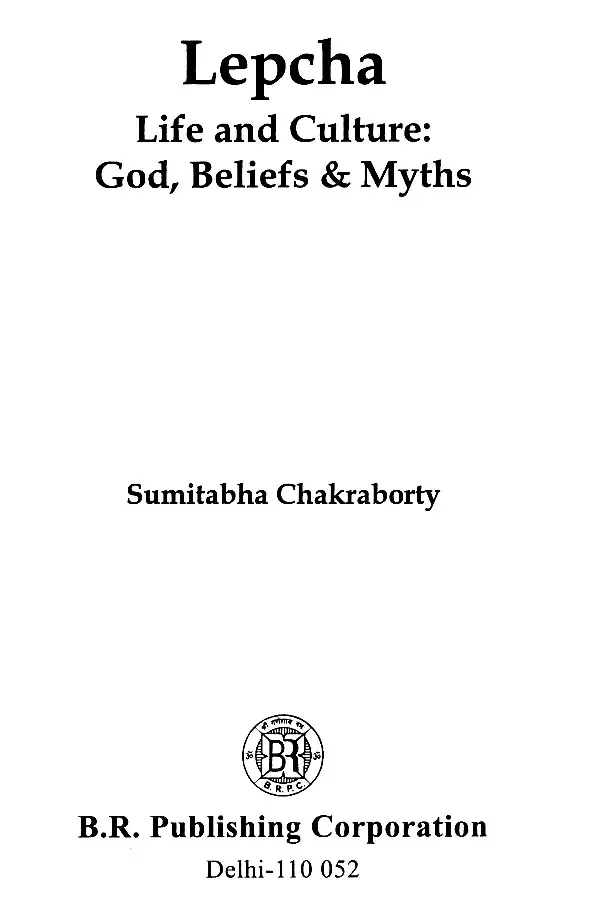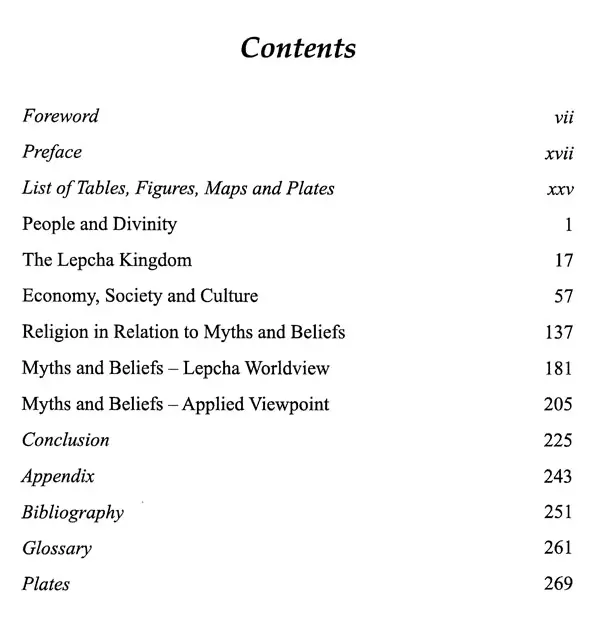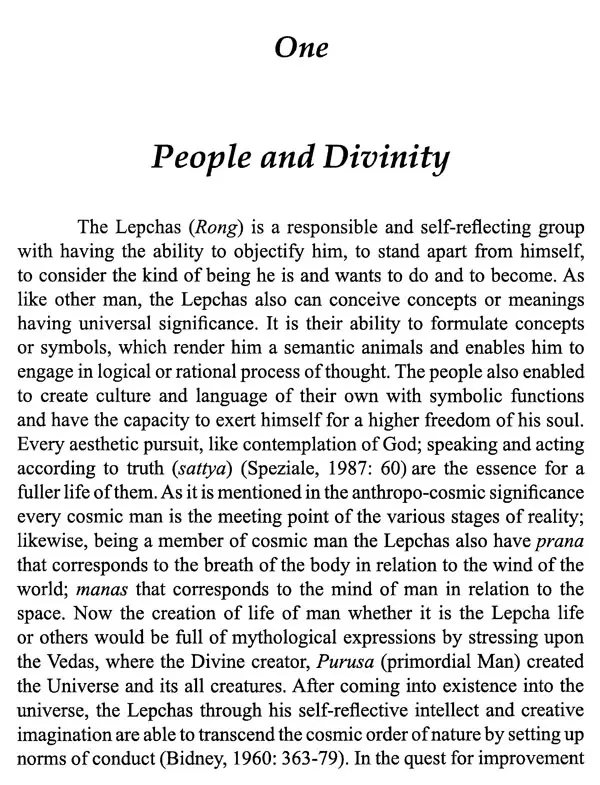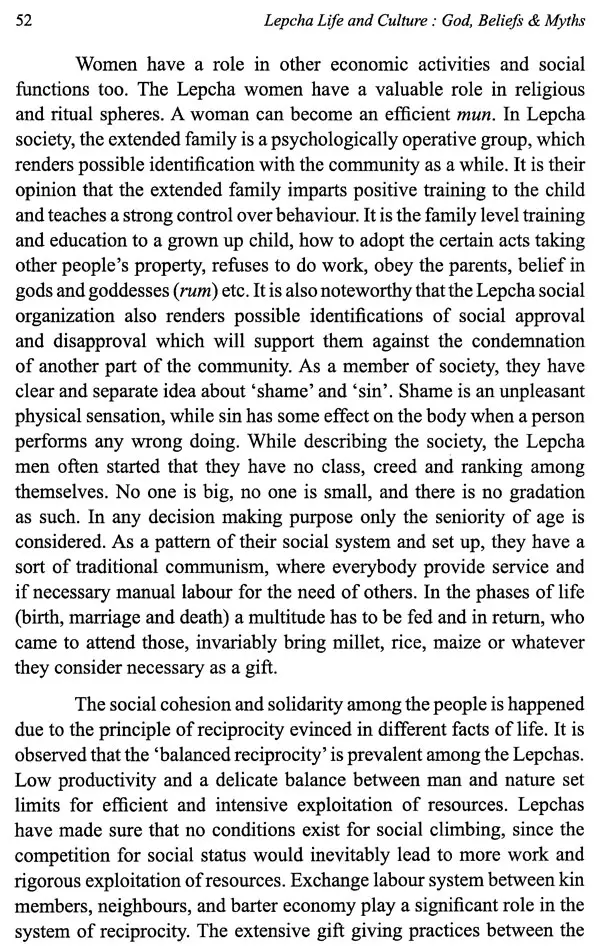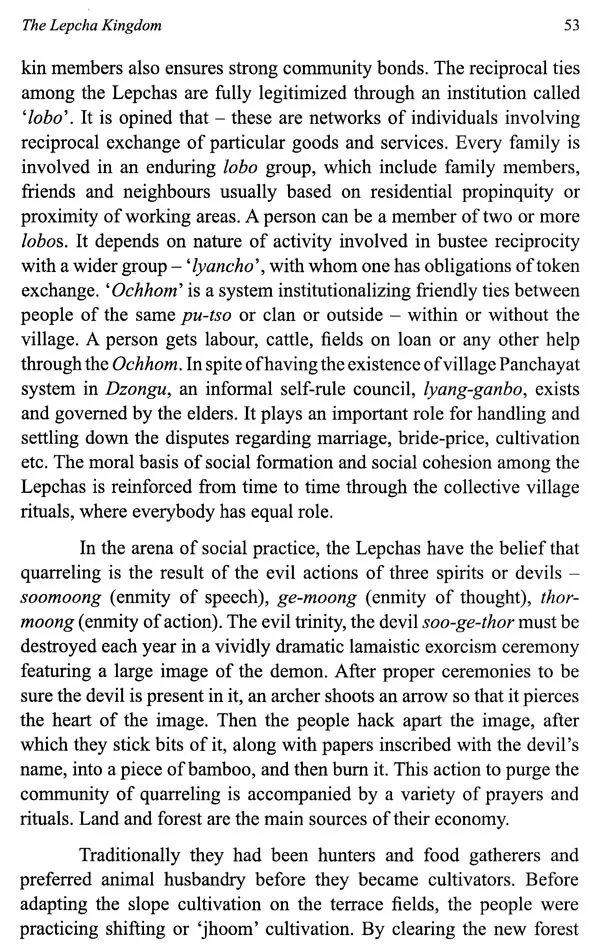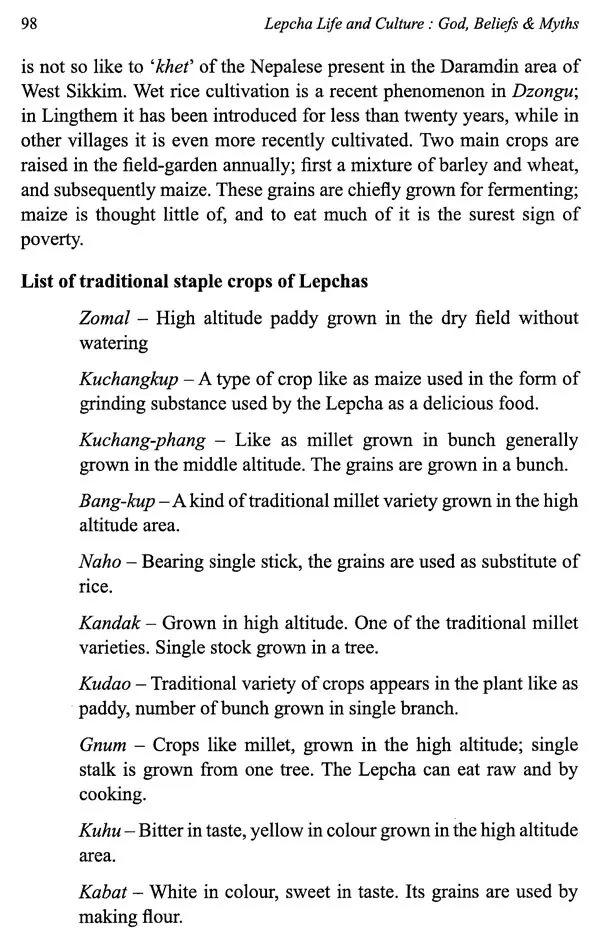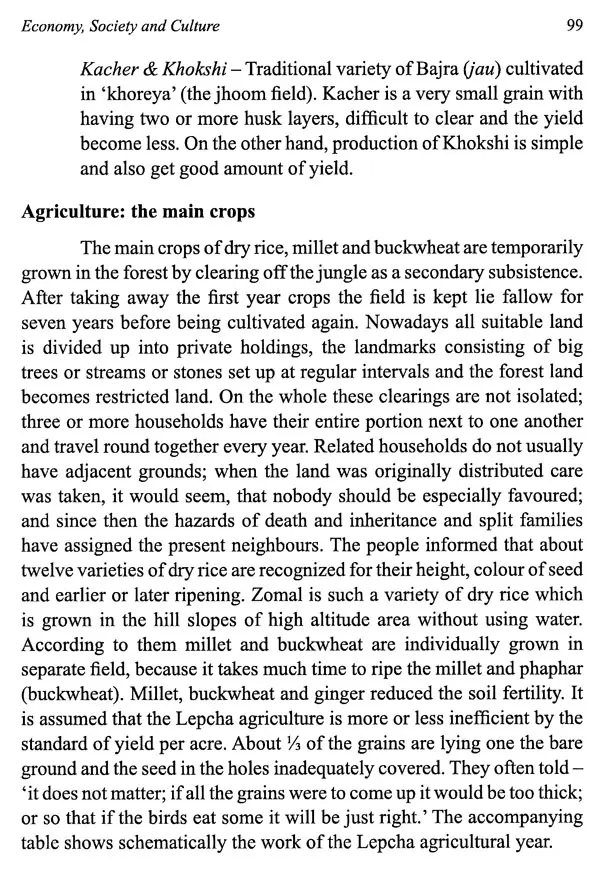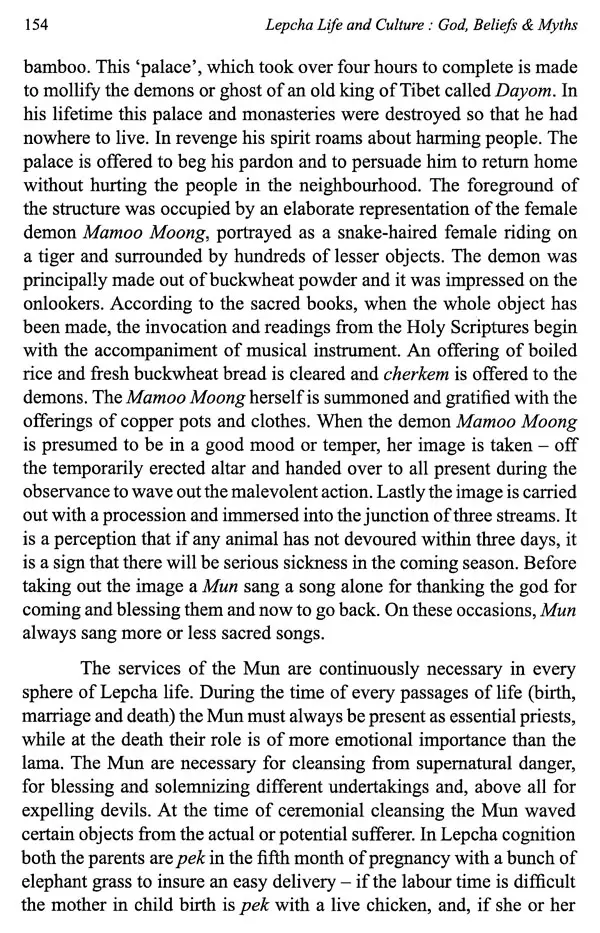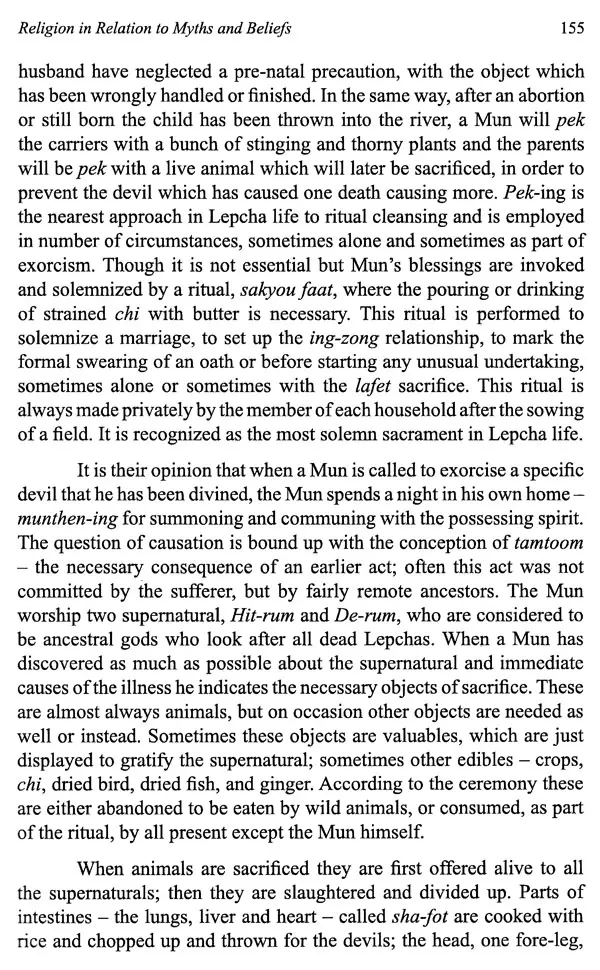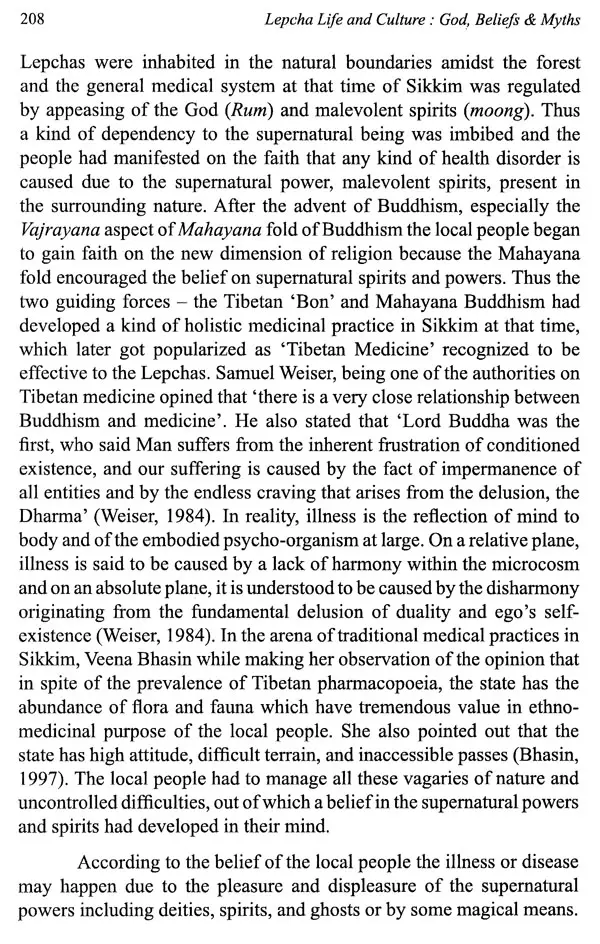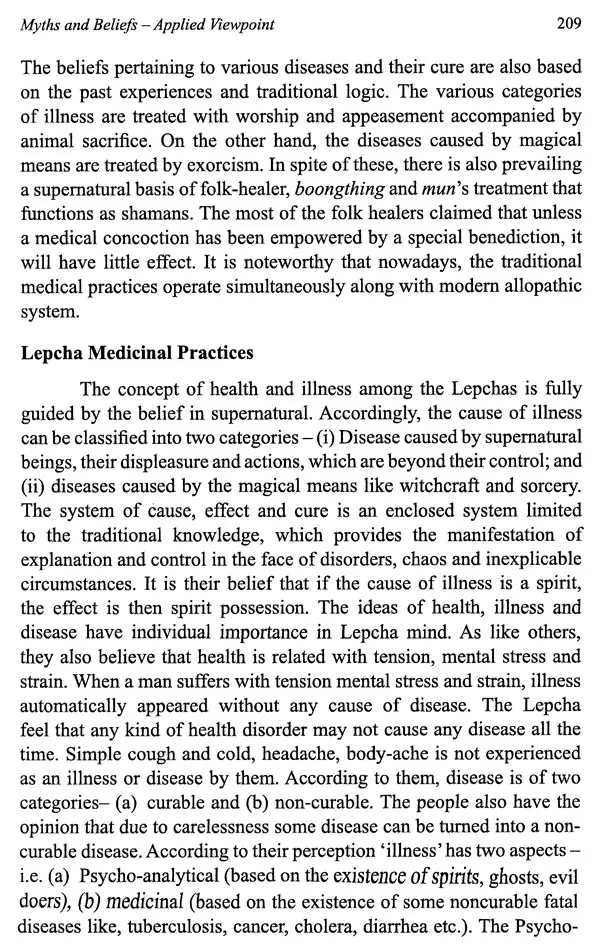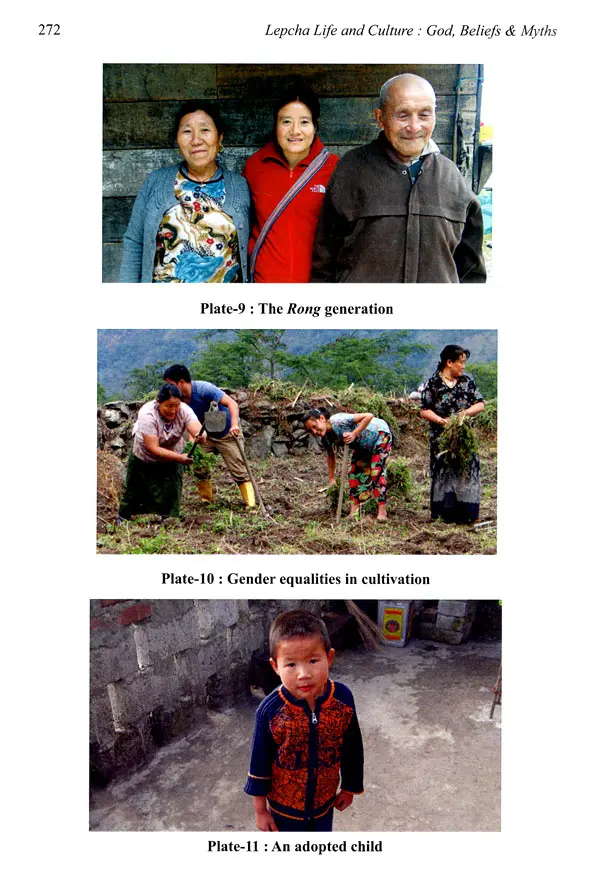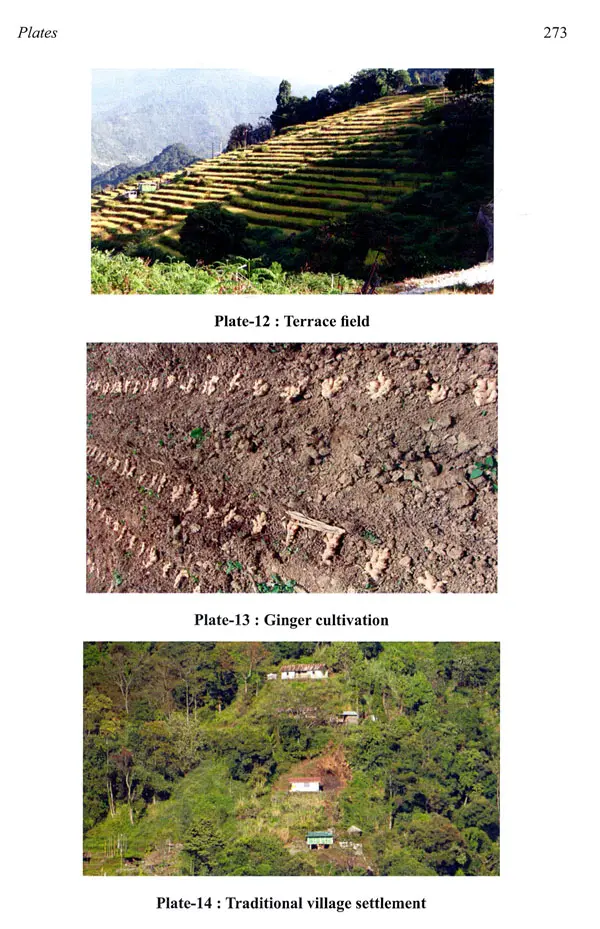
Lepcha Life and Culture: God, Beliefs & Myths
Book Specification
| Item Code: | UAP864 |
| Author: | Sumitabha Chakraborty |
| Publisher: | B.R. Publishing Corporation |
| Language: | English |
| Edition: | 2021 |
| ISBN: | 9789388789677 |
| Pages: | 304 (Throughout Color Illustrations) |
| Cover: | HARDCOVER |
| Other Details | 9.50 X 6.50 inch |
| Weight | 630 gm |
Book Description
In the quest for improvement in level of living, the Lepchas constantly tries through an arduous effort to survive against the elements of nature and ultimately acquire the authority by gradual ascendancy in the mastery over nature. The Lepcha people has his own ideation, knowledge and creation. As being on the lap of nature, the people has also to acquire the quality of harnessing the natural environment. The people has also made an effort to find out cause and effect relationship of the natural phenomenon happened in day-to-day life with belief on spiritual being-God and moong. The idea of 'spirituality' is conceptualized as a product of myths based on beliefs, the guiding force of the Lepchas.
The Lepcha continue to live and die with copious validating spiritualism and theology based on beliefs and rituals reliant with mythical narratives. Everything around them is visible and invisible, animate and inanimate, and the passages to their present state are told in a great number of stories with varying emotional importance. The Lepcha's cultural construct of myth and magic is based on an intricate balance of power between the powerful and the powerless.
Sumitabha Chakraborty (b. 1965), M. Sc. Ph.,D., is a Social Cultural Anthropologist presently attached to the Anthropological Survey of India, Ministry of Culture, Government of India. He has done number of research study among the tribal and non-tribal communities of India, of which the Jarawa of Andaman Islands, Shompen and Nicobarese of Nicobar Islands; Kinnaurese of Himachal Pradesh are most important. He has carried out research study on Biosphere Reserve in India; Social Impact Assessment of the Vedanta Alumina in Kalahandi of Odisha; Study of Land Acquisition and land reforms in the growing up urban centre. He has also recently carried out research study on the Denotified communities of West Bengal, Odisha, Uttar Pradesh and Dadra and Nagar Haveli.
It was a fine monsoon day when I reached at the lap of the tiniest state, Sikkim getting drenched with heavy downpour. I was overwhelmed with the magnificent bounty of nature and eye-catching view of the mountain ranges of Khangchendzonga. That was the first encounter I had with Sikkim for a research study on Khangchendzonga Biosphere Reserve. As days passed, many new experiences and ideas started staunching, getting accumulated and knocking the doors of curiosity about the symbiotic balance of nature-man-spirit. While working among the tribal people of Sikkim, especially with the Lepchas, their life, culture and society seems to be inextricably bound with the nature and natural being for which they have separate belief system based on myth and magical practices. Particularly, the interconnection and interrelation of nature-man-spirit instigated me since the beginning to enquire with more close and deeper introspection.
The Lepcha continue to live and die with copious validating spiritualism and theology based on beliefs and rituals reliant with mythical narratives. Everything around them is visible and invisible, animate and inanimate, and the passages to their present state are told in a great number of stories with varying emotional importance. To them, the world is an ocean, under that ocean there is an earth, and underneath of that there lives It-boo-mu, the creator mother and her husband De boo. In the context of myth and magic there is a hierarchy of relations between Rum (God), Moong (spirits), human beings and animals share a common space through which all of them move. The Lepcha's cultural construct of myth and magic is based on an intricate balance of power between the powerful and the powerless.
Lepcha myths not only establish the formation of space, but also distinguish supernatural groups on the basis of movement-those who fly in the world of light, those who walk in the world of shade and those who sank in the dark world under the soil. These supernatural being can move on both the vertical and horizontal axis, what a Mun (exorcist) follow minutely at the time of exorcism. That power is the ability of a Mun to move himself in the totality of space during his transcendence. Considering movement and its pattern as derived from ritual and myth, an idea of power and cosmology is emerged. To the Lepcha's worldview, power of spiritualism is always associated with the spatial coordinates. When the spirits come down and enter deep into the ground death occurs. The use of magical substances and magical practice would be useful to effect transformation from powerlessness (in relation to the spirits) to safety.
The well-known amorality of myths is intimately connected with their existential bearing. The myth does not describe what ought to be done; it expresses what must be done. The behaviour in myth must perform or feign to perform, in act or in fantasy. Lepcha myths afford precedents and sanctions for social status and moral rules require some sort of qualifications. The magical practice is directed to specific ends and differs from religion is not being concerned with the worship of spiritual beings rather it is a non-uniform class of practices and beliefs. Being a witch, a mun always perform the best practices in regard to the supernatural or divine powers, where logic acts showing structure, division of labour and specialization of function.
Throughout this book, an attempt is made to reclaim the concept of myth and magic according to Lepcha cognition. It is also tried to find out that various exogenic factors like modern education, better livelihood practices and assimilation of other cultures would affect the traditional system of myths and magical performances to a greater extent in the development outlook.
It is indeed with a sense of joy and satisfaction that as the Tagore National Fellow of the Ministry of Culture, Government of India, I have been requested by the publisher of an esteemed publishing house to write the FOREWORD of a book authored by Dr. Sumitabha Chakraborty, SANSKRITI Fellow of the Northeastern Institute of Culture and Research and a professional anthropologist attached to the Anthropological Survey of India, Ministry of Culture, Government of India. In fact, Dr. Chakraborty had been a part of the anthropological activity in the northeastern state of Sikkim for over a decade, apart from his other assignment at Tripura. During his tenure of fieldwork there, he developed the concept of undertaking a research on the Lepcha, one of the most important tribal groups of the state. Incidentally, I was serving the state then on an assignment of fieldwork as a government of India employee, when I had the opportunity of working with him in the same academic forum of a national project on Khangchendzonga Biosphere Reserve. Secondly, I had been a researcher in northeast India since 1994 when I started working in one of the frontier states of the region. Over this span of more than twenty-five years, I have been visiting the different states of this frontier region for a longitudinal research of the land and its subjects in the dimensions of time and space.
However, at the same time wisdom would have placed me in the reader's table, a most distinguished one, may be in a desolated corner of a library, where many are far more intimately aware than I am of the recent intellectual developments. I am just a student of anthropology by training and profession. I can only assume that Dr. Chakraborty's invitation is more a gesture of affection and friendship than a tribute to his otherwise sound judgment. I am not at all sure that it was wise to succumb to the affectionate invitation and pressure of Dr. Chakraborty and his publisher agreeing to write the Foreword for his book. I agreed essentially because Sumitabha, as we all call him, is a friend of long standing and in the years of our association I have never failed to be impressed by his originality, sincere efforts and insight. However, I am grateful to him for this honour. It gives me an opportunity to acknowledge my own personal gratitude also. Finally, as a matter of just discussion, I want to place on record that I was incidentally attached to his Ph. D. dissertation informally, since he conducted his doctoral research under my close friend and my batch mate, when I had the opportunity to go through his final draft on a number of occasions. Keeping the ethno cultural profile of a vast territory called northeast India I take the latitude of introducing the area first that makes it distinct from other parts of the country, where the Lepcha inhabit since time immemorial as one of the oldest indigenous groups.
Book's Contents and Sample Pages
